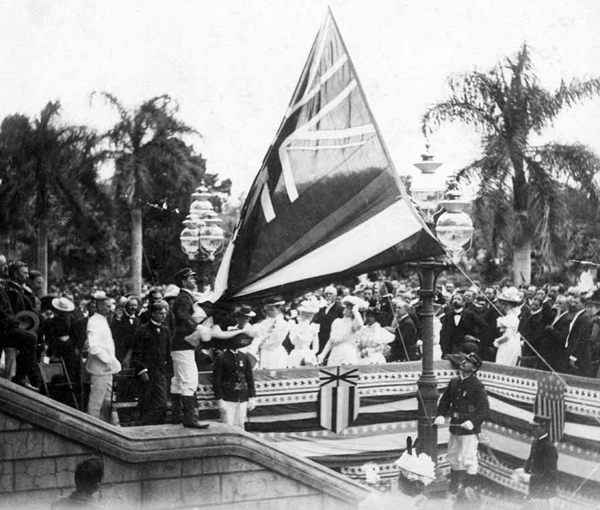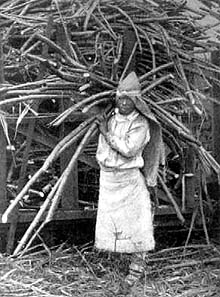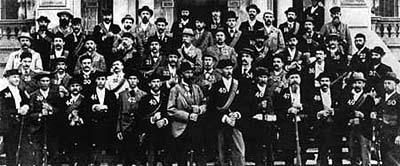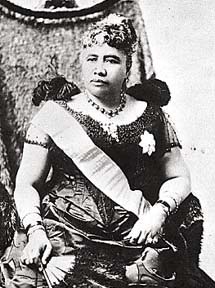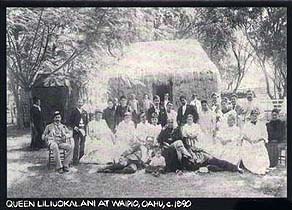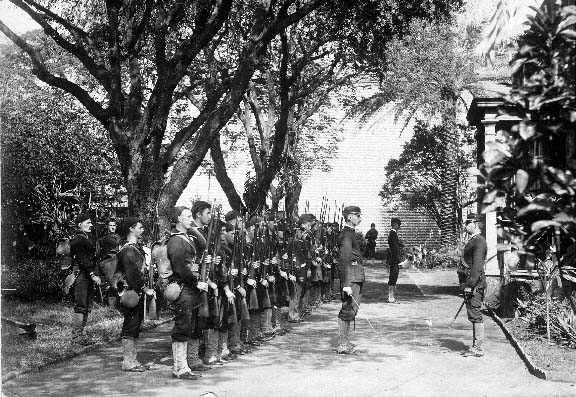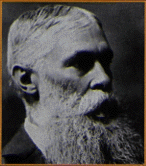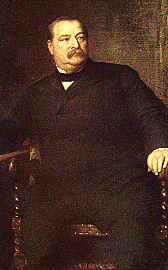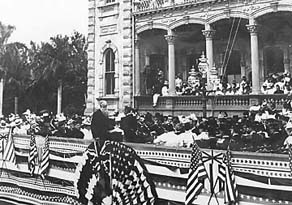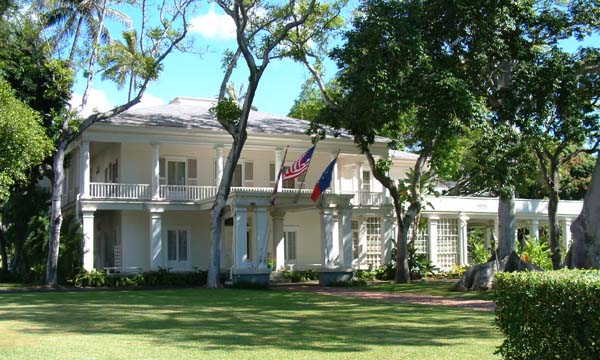 |
 |
 |
|||||||||||||||||||||
|
|
|
|
|
|
|
|
|
||||||||||||||||
|
|
|||||||||||||||||||||||
| |
|
|
|
“There are several different factors that led up to what I no longer call the 'overthrow,' but a combination of military invasion and a coup d’etat," Noenoe explains, "primarily by American-identified business men and their descendents. There had been cultural and economic colonialism going on for a long time in Hawai‘i since the arrival of the missionaries in 1820. And inseparable from that was the establishment of capitalism, very much like any other kind of colonial capitalism.”
|
||
|
|
||
| “The Sugar Planters wanted to sell their product to the United States. Hawai‘i was a separate country, so they had to keep maneuvering to get trade agreements—reciprocity treaties—to allow duty-free trade. That involved a lot of negotiation, and these Planters and folks who felt that they should be ruling Hawai‘i would put pressure on the King to do whatever needed to be done to make sure that the sugar industry was going as well as it could. “And with these Reciprocity Treaties, the United States made demands over the years. They wanted to have exclusive use of Pearl Harbor. King Kalakaua was not about to give up Pearl Harbor. "So finally in 1887, Sanford Dole and Lorrin Thurston and these other non-Hawaiians just went to him and said, ‘We’re taking over your government. We’ve written a new constitution stripping you of your powers. You need to sign this new constitution and if you don’t sign it, we’ll kill you.’ Sanford Dole said that in his memoirs. They were not ashamed of that."
|
|
|
|
"A totally unacceptable constitution had been forced on him," Jim Bartels relates, "that he had been made to sign in his palace, which had been his own symbol of the continuity of Hawaiian royalty. That was a tough time." “That was the beginning of the Overthrow," Noenoe continues, "because that stripped him of his powers. It imposed heavier property requirements for voting, so people could only vote for the upper house of the legislature if they had so much property, or a certain income. "And this was all to make sure that the Planters themselves were controlling the government. That’s what they called ‘democracy,’ and they made it an oligarchy."
|
|
“Hawaiians protested immediately and continuously against that. There was a process in the old constitution for how to amend the constitution or create a new one. And this wasn’t done like that at all. Then in 1889, Hawaiian leader Robert Wilcox tried to rush the Palace with guns to force Kalakaua to sign back onto the old constitution, and of course that failed. Kalakaua died in January 1891, while on a trip to San Francisco, and his sister took over the throne."
|
||
|
|
||
|
|
"Lydia Kamakaeha Paki, hanai child of Abner Paki; a great musician, from a powerful family," Jim Bartels explains. "She was charming, talented, not pretty—handsome, very distinguished, extremely well educated. She had gone to the Royal School that had been set up for royal children, and could handle herself beautifully in Hawaiian contexts and amongst foreigners as well. She was raised to be a lady. Around 1860 she fell in love with this young American, John Dominis Holt, who is the son of the builders of Washington Place." “Lili‘uokalani didn’t believe in the Bayonet Constitution
at all," Noenoe says, "but just hours after
learning of her brother’s death, and while still in shock, she
was advised to take an oath swearing to uphold it. Her husband told
her to go ahead and do it, and she did—and regretted it almost
immediately. But then she did everything she could. And she was deluged
with petitions and people constantly coming to her saying, ‘you
have to get rid of that constitution, we have to take control of our
country back.’"
|
| “Finally in January of 1893 she tried to put in a new constitution. Prior to this, the Minister of the United States, John Stevens, had already been talking a lot with both U.S. Secretary of State Blane, who was his former business partner, and with Sanford Dole and Lorrin Thurston and the oligarchy here. He’d been writing letters saying, ‘if you guys ever want to depose her, sure, I’ll back you up, in fact this is how we should do it….’ There was a lot of conspiring going on. “So on January 14, 1893 when the Queen tried to put a new constitution into place—which was reportedly almost exactly the same as the constitution previous to 1887—these men completely over-reacted. Her Cabinet wouldn’t sign on to the new constitution, and according to the Bayonet Constitution, she couldn’t do anything unless her Cabinet approved it first. "She was sort of caught in this trap of wanting to overthrow a
constitution which had provisions in it that were keeping her from overthrowing
it. She was trying to do things in a pono way, which maybe
you can’t do in such a un-pono situation."
|
|
|
The USS Boston. |
“On January 16th, Stevens decides to land the troops from the U.S.S. Boston. And they’re marching up and down doing drills in front of the Palace, threatening the Queen. And then on the 17th, the Committee of Safety went to Ali‘iolani Hale, which was empty except for a janitor, and read a proclamation saying ‘We’ve taken over this government building and we are now the Provisional Government’ and so forth. "And then they went to the Queen and said, ‘This is what we’ve done, and we’ve got the Marines.’ Lorrin Thurston stayed in bed that day. He claimed to have a cold. "From what we understand", says Lynette, "people from the Palace -- up on the second floor -- could see the ships in the harbor. The harbor was closer, and there were no buildings there, so when you read in the accounts that the USS Boston was in the harbor pointing their guns at the palace, they were RIGHT there, and everybody at the Palace could see them. It's not like it is right now. It was very intimidating."
|
|
|
|
|
American troops landed from the USS Boston to assist
the "revolution."
|
||
| “It was a hostile occupation at that point. The United States Marines had landed without asking permission of the government. They were saying they were there to protect American lives, which were under no threat at all—nothing happened. “The Queen’s response was to yield, surrender temporarily to the superior military force of the United States. "She knew how small the population of Hawaiians was at that time," Jim Bartels explains, "and we know from her writings that it was crucial to her that Hawaiian blood not be shed."
|
||
|
|
||
| “This Provisional Government immediately prepared a treaty of annexation, which would solve the problem of sugar marketing and also that would really ensure their rule. If they did not have to deal with the Hawaiian ali’i at all, then that would be an ideal world for them, politically, economically and socially. “They sent their representatives with this Treaty of Annexation up to Washington. They wouldn’t let the Queen’s representative get on the boat, but her letters got on—some of them were smuggled, I think. But the Provisional Government’s representative got to Washington a week ahead of hers, and their Treaty of Annexation was signed by outgoing President Harrison and sent to the Senate. “As soon as Cleveland came in, he pulled the Treaty out of the Senate and launched an investigation. He sent James Blount, a former senator from Georgia over here, who stayed here for a couple of months and conducted a very long and thorough investigation."
|
|
|
“Blount’s report concluded that this was completely wrong, that ‘it was an act of war against a friendly country with whom we hold trade treaties and whose independence we’ve promised to respect, and this just shouldn’t happen. The majority of people in Hawai‘i don’t want to be annexed to the United States.’ “In December of 1893 Cleveland announced this determination in a long speech about how it was an act of war, and he wrote to Sanford Dole saying he’d done an investigation and determined that this was wrong. He told Dole he needed to turn the government back over to the Queen and make this right. Sanford Dole wrote back to Cleveland, saying, ‘You have no business interfering in the internal affairs of our country'."
|
|
|
|
"It's important to note that the Queen did not abdicate in 1893," Noenoe points out, "but only temporarily yielded to avoid bloodshed. While imprisoned 1895, she was coerced into signing a statement of abdication—having been threatened with execution and with the execution of her supporters. She always disavowed the legitimacy of that document. The original coup happened in 1893, but the Annexation did not happen until 1898, finally becoming official with the Organic Act in 1900. That’s seven years of struggle." Noenoe descibes the events of this period on the following pages: Despite effective lobbying by the Queen against the annexation, larger world events intervened: "The Spanish-American War was starting," Noenoe explains, "and that was an opportunity for America to do one big giant grab at once. And that’s what happened." "So in 1898 the United States, under President McKinley, annexed the islands through a joint resolution of Congress, now determined to be illegal under both the U.S. Constitution and international law; and through the Organic Act of 1900, made the Hawaiian Islands a U.S. colony called The Territory of Hawaii."
|
||
|
|
||
|
|
| "Lili‘uokalani remained in Washington Place because it was a power place," Jim Bartels concludes. "Very uncomfortable to live in. There were peeping toms, and she was constantly being harassed. But she stayed there for the last 24 years of her life, between long trips to Washington D.C. Up until 1910, she made trips every year or so, staying away as long as a year and half, trying to get some resolution to Hawaiian issues. And in the end, failed. "She comes home, tries to live the rest of her days as a positive symbol for Hawaiians, and then dies very peacefully, on November 11, 1917."
|
||
|
|
||
Washington Place is one of many grand homes in the Nu‘uanu area, that came into being both before and after the overthrow of the Monarchy. Another is Queen Emma's Summer Palace, also known as Hanai-a-ka-malama.
|
||
|
|
||
| |
| |
|
|
 |
| Nu‘uanu Home | Map Library | Site Map | Hawaiian Islands Home | Pacific Worlds Home |
|
|
|||
| Copyright 2003 Pacific Worlds & Associates • Usage Policy • Webmaster |
|||
